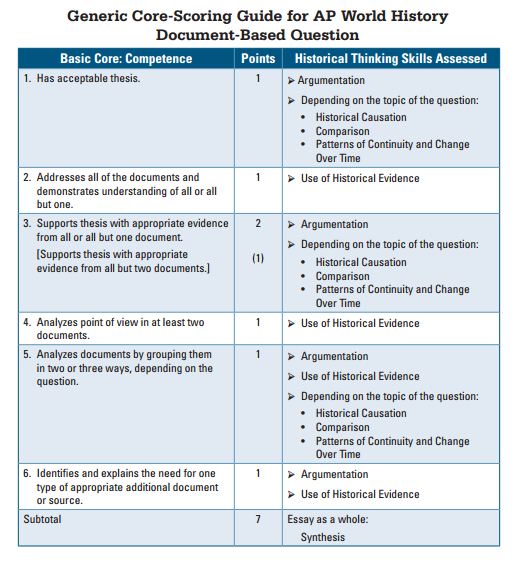|
RESOURCES FOR THE DBQ ESSAY:
|
DOCUMENT-BASED QUESTION ESSAY
The primary purpose of the document-based essay question is not to test students' prior knowledge of subject matter, but rather to evaluate their ability to formulate and support an answer from documentary evidence. It is assumed that students have taken the course and understand the broader world historical context. Documents are chosen on the basis of both the information they convey about the topic and the perspective that they offer. The document-based essay question is designed to test skills described in the four historical thinking skills, that are analogous to those of the historian analyzing source materials. However, the document-based question differs from the task of actual historians mainly in the time available for analysis and the prearranged selection of the documents. There is no single "correct" answer; instead various approaches and responses are possible, depending on the students' ability to understand the documents, communicate their significance, and construct an argument. In writing the essay, students may find it useful to consider the following points. The document-based question is an exercise in crafting historical arguments from historical evidence and synthesis. Additionally, depending on the topic of the question, students may also be asked to analyze historical causation, make comparisons, and/or discuss continuity and change over time as part of the document-based question exercise. The document-based question requires that students first read and analyze the documents individually, contextualize them based on their informed analysis of the documentary evidence, and then plan and construct an appropriate and synthetic essay in response to the question. The student's answer must group documents in such a way that it demonstrates analysis of their different contents and contexts. A clear thesis statement and an analysis of the documents that fully address the question are required.
It is expected that students will use all or all but one of the documents. Specific mention of individual documents should always occur within the framework of the overall topic, serving to substantiate and illustrate points made in the essay. In no case should documents simply be cited and summarized in a list; reference to the documentary material must always be closely tied to the essay question. Evidence from the documents should be utilized both to construct arguments and to illustrate specific points within those arguments. Students should cite documents by naming the author, title, and/or document number. Students may group documents chronologically, culturally, or thematically, as appropriate, to demonstrate their ability to analyze sources, but they are not expected to have particular knowledge of every document's author or topic or to include knowledge outside of the documents in order to receive the highest score. The number of documents will be between 4 and 10; they will be of sufficient length to encourage comparisons, contrasts, and analyses. Every document is related to the question. Critical judgement is essential in responding to a document-based question. Analysis of the documents must include consideration of their context, point of view, and frame of reference. Students should pay attention to both internal evidence (the content, format, and tone of each document in relation to the others) and external evidence (identification of the author, purpose, or intended audience, and the date on which each document was written). This analysis of context may serve as a way for students to group documents, as they highlight similarities or differences in perspective among the documents. As part of the document-based question exercise, students will be asked to explain the need for an additional type of document(s) to answer the question more completely, and this may involve discussing what relevant points of view are missing from the set of documents. The explanation of at least one additional source must show the student's recognition of the limitation of the given documents and the reality of the types of sources available from the past. | ||||||||||||||||||||||||||||||

